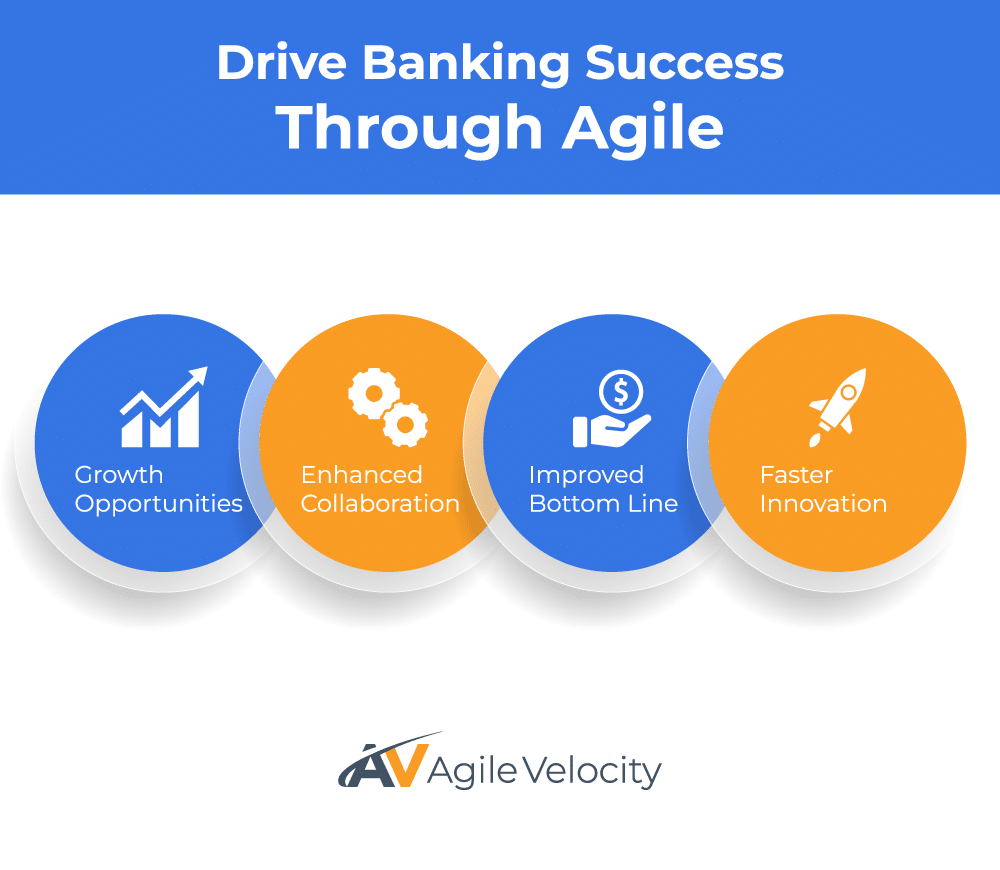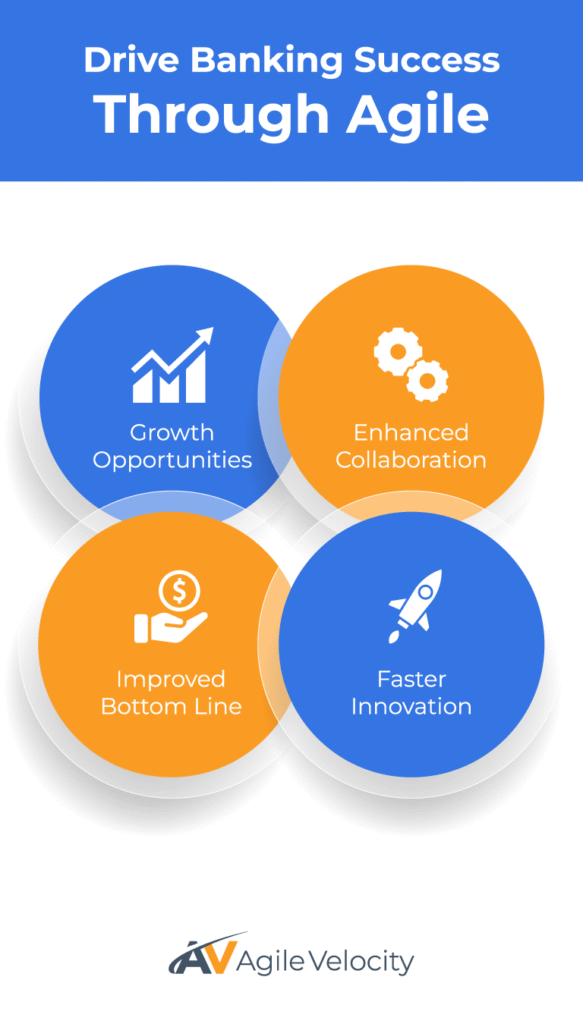In today’s financial world, banks face constant pressure to innovate and meet rising customer expectations. Traditional methods often fall short in providing the swift, personalized attention that modern customers demand. Agile Transformation isn’t just a buzzword, it’s a strategic approach enabling banks to adapt quickly, fuel innovation, and deliver outstanding value.
This article explores why agility is vital for banking institutions, shows how Agile can boost success, and explains how coaching and guidance tools can help banks map their Agile journey, track improvement, and achieve sustainable change.
By shifting from traditional, hierarchical structures to Agile practices, banks empower their teams to break down silos, make data-driven decisions, and embrace a mindset of continuous improvement. Whether you’re a banking executive, financial leader, or member of a Scrum Team, these insights can help embed agility into your organization’s DNA for ongoing growth and relevance.
The Growing Importance of Agility in Modern Banking
Banks encounter unrelenting pressure from fintech disruptors, evolving customer expectations, and stringent regulations. When organizations rely on older, rigid processes, they struggle to keep pace with market changes. Delays in implementing updates or launching new products can result in lost opportunities and dissatisfied customers.
Agility addresses these challenges head-on, offering a framework that accelerates innovation, fosters collaboration, and maintains compliance. By embracing Agile Transformation, banks can quickly adapt to shifting demands, consistently deliver value, and create new revenue opportunities. Ultimately, banks that build agility into their culture can set themselves apart through superior customer experiences, and operational excellence.
Pressures of the Digital Age
Banks today operate under overlapping pressures:
- Fintech Competition: Tech-driven newcomers redefine the financial landscape, thriving through quick product updates and highly personalized services. If banks remain slow in adopting new ideas, they risk losing to more flexible market entrants.
- High Customer Expectations: Customers have grown accustomed to seamless digital experiences. Whether they’re checking balances or applying for loans, they want reliable and efficient service.
- Regulatory Demands: In the financial sector, any innovation must also meet strict regulatory standards. Banks need processes that incorporate compliance and risk management early in development cycles to avoid setbacks.
When banks emphasize agility, they gain the flexibility to respond to these forces. Rather than being reactive, they can proactively identify market opportunities and deliver compelling solutions.
How Agility Drives Banking Success
An Agile culture dissolves traditional silos by empowering teams with iterative development cycles, clear roles, and continuous feedback loops. Adopting an Agile Transformation allows leadership to enable strategic, customer-focused decisions, helping banks thrive in a market where customer loyalty is often fleeting.
Through regular inspection and adaptation, banks can roll out enhancements faster, refine them based on real-world feedback, and see tangible improvements in their bottom line. Banks that successfully embed agility into every layer of the organization see better employee engagement, higher customer satisfaction rates, and improved compliance structures, all achieved with less friction.
How Agile Transformation Benefits Modern Banks
Agile Transformation unlocks a host of advantages for financial organizations seeking a competitive edge. By incorporating Agile Methodologies, banks streamline operations, respond faster to marketplace changes, and harness cross-departmental collaboration to create innovative products and services.
Responding Faster to Customer Needs
Customer satisfaction is essential in banking, especially as clients increasingly expect personalized, on-demand service. Frameworks such as Scrum break projects into manageable Sprints, making it easier to secure continuous feedback and evolve services quickly. Meanwhile, Kanban’s visual approach reduces bottlenecks by highlighting where improvements are needed and when.
Faster feedback and incremental releases help banks deliver tangible improvements more frequently. This provides proof-of-progress to both internal stakeholders and regulators. Whether it’s upgrading mobile banking features or rolling out new AI-based services, quick delivery cycles ensure innovations keep pace with real-time customer demands.
Creating Exceptional Customer Experiences
Agile practices place the customer at the center of every process. With frequent iteration and user feedback, banks can finetune each product release—whether introducing new digital lending solutions or refining mortgage applications—and continuously enhance the overall user experience.
Moreover, an Agile approach ensures new features are validated by real users early and often, minimizing the risk of misaligned products. This approach builds confidence among both development teams and customers, leading to long-term loyalty and positive brand perception.
Boosting Efficiency and Collaboration
Agile Transformation encourages high levels of transparency, ensuring everyone understands project priorities and deliverables. The practice of lean management and Agile can prioritize high-value work, limiting wasted time and resources. Similarly, Work In Progress (WIP) limits can prevent teams from juggling too many tasks simultaneously.
This combination of clarity, collaboration, and focused workflows often leads to:
- Higher employee engagement, as teams clearly understand goals and accountability.
- Reduced miscommunication, because visible boards and lightweight artifacts keep people on the same page.
- Enhanced speed in addressing issues, as impediments become evident and can be resolved promptly.
Banks that effectively implement Agile create a culture of continuous improvement, eliminating inefficiencies, and cultivating cross-functional partnerships.
Key Steps to Successfully Embrace Agile in Banking

Transitioning from hierarchical models to Agile workflows can be challenging, particularly in a heavily regulated environment like banking. Yet, with strong leadership, clear communication, and sustained commitment, Agile becomes a driving force for organizational success.
Leadership Alignment and Championing Change
Senior leaders must fully support Agile Transformation. They should model transparency, broadcast a clear vision, and rally teams around Agile values. Active leadership participation in Agile events—like Sprint Planning or a Daily Scrum—signals the importance of the transformation, motivating teams to follow suit.
Organizations often discover that when executives own the cultural shift and enforce accountability, employees feel validated in raising potential issues and suggesting process improvements. By aligning every layer of the bank—executives, managers, and associates—on the importance of agility, the entire enterprise benefits from consistent, cohesive change.
Building Agile Skills Through Training and Coaching
Investing in skill development fosters long-term results. Agile coaching and workshops are valuable for team members looking to deepen their knowledge of Agile roles and responsibilities. Browsing advanced modules and specialty certifications can further enrich banks’ capability to handle diverse projects.
Practical assistance, such as Agile Transformation services, helps teams apply their new learning in real-life settings. Coaches offer customized guidance, address resistance to change, and reinforce productive mindsets—especially important for employees grappling with entirely new processes.
Transitioning from Legacy Systems to Modern Practices
Many banks still rely on monolithic, legacy systems that can be inflexible. Migrating to more adaptable platforms—using microservices, AI Solutions, or cloud-based architectures—enables smaller, incremental improvements. This lowers the risk that can come from a total system overhaul. Additionally, some banks are adopting AI Solutions for Banking that integrate well with Agile ways of working, facilitating faster insights and innovation.
Gradual modernization helps ensure business continuity while letting teams adopt Agile practices in manageable steps. Banks can then add improvements incrementally, continuously testing new features in shorter cycles. Over time, these incremental adjustments create a robust foundation that supports both innovation and stable operations.
Leveraging Agile Methodologies to Transform Banking
Agile Methodologies give banks the tools to operate with greater responsiveness. By selecting or adapting the best framework for each project, financial institutions can find balance between flexibility and control, aligning development with organizational goals.
Agile Frameworks Best Suited for Financial Institutions
Different banking contexts may call for different frameworks:
- Scrum: Breaks development into time-boxed Sprints, ensuring continuous feedback and transparency.
- Kanban: Visualizes work items, promoting a steady flow of tasks and limiting bottlenecks.
- Scaled Agile Framework® (SAFe®): Aligns multiple teams through Agile Release Trains, leveraging synchronized Iterations to manage large-scale initiatives.
- Lean Portfolio Management: Connects the organization’s strategic goals with execution, ensuring that investment decisions align with high-priority outcomes.
By choosing a framework that resonates with a bank’s structure, resources, and product objectives, teams can streamline operations without losing sight of the customer or compliance requirements.
Building a Customer-Centric Approach
In a competitive market, creating products that meet real customer needs is paramount. Agile frameworks help teams iterate quickly, gather customer input, and integrate changes in shorter cycles. When banks adopt iterative development, they can tweak features, address usability concerns, and update functionalities as soon as new requirements surface. Additionally, Large-Scale Scrum (LeSS) Implementation Guidance can help bigger institutions coordinate multiple teams while keeping customers front and center.
This approach also fosters collaboration among cross-functional teams, including marketing, operations, and risk management. As a result, banks better anticipate user requirements, decrease development time, and produce more impactful solutions.
Path to Agility Navigator: A Blueprint for Transforming Banking Operations
For banks looking to integrate Agile practices effectively, it’s essential to have a structured way to measure progress and identify areas for improvement. The Path to Agility approach offers a strategic roadmap, helping institutions gain visibility into their transformation and track meaningful outcomes. Using a software called Path to Agility Navigator in conjunction with this approach can help banks track progress and make informed decisions throughout their Agile journey.
Transforming Agility with Path to Agility Navigator
Path to Agility Navigator is designed to help organizations focus on actionable results over arbitrary framework adoption. Rather than simply following prescriptive steps, teams use Path to Agility Navigator to uncover improved ways of working, tracking tangible changes in efficiency and output.
This tool presents a clear overview of an organization’s maturity level across key dimensions—from leadership alignment to delivery speed. This clarity helps banks take practical steps on their Agile journey without losing sight of regulatory obligations or customer needs.
Benefits for Banks Utilizing Path to Agility Navigator
Banks that rely on Path to Agility Navigator often see:
- Advanced Visibility: Comprehensive dashboards ensure leadership and teams remain in sync, accelerating decision-making.
- Reduced Guesswork: By examining data points, stakeholders gain clarity about where to invest in process improvements.
- Incremental Delivery: Path to Agility Navigator’s insights prioritize quick wins, which build momentum and demonstrate early progress to both external and internal audiences.
Because this solution focuses on outcomes, banks stay aligned with real-world results rather than chasing hollow metrics or half-hearted transformations.
Sustaining Agility Through Continuous Insights
Agile Transformation is an extended journey that demands regular adjustments. Path to Agility Navigator guides organizations through ongoing improvements, making it easier to refine practices and reinforce beneficial patterns. By reviewing incremental gains and recalibrating as necessary, banks prevent stagnation and maintain a culture of continuous improvement.
Sustained agility ensures that banks don’t revert to slow, inefficient processes. Instead, it helps them maintain an iterative mindset, where every Sprint or iteration becomes an opportunity for learning, refinement, and greater value delivery.
Overcoming Challenges in Banking Agility Adoption
Agile Transformation can reshape a bank’s processes and culture—but shifting from traditional habits isn’t always straightforward. By handling resistance strategically and balancing compliance demands, organizations can ensure progress without jeopardizing stability or trust.
Addressing Resistance to Change
Fear of the unknown often fuels skepticism. Employees who are accustomed to top-down directives may worry about new workflows that emphasize transparency and shared accountability. Early communication, guided by knowledgeable Agile coaches, can alleviate uncertainty. Celebrating small wins—like a successful Sprint or a product launch that resonates with customers—also helps teams appreciate the benefits of working in an Agile environment.
When managers approach Agile with authenticity and empathy, they forge an environment where people are more willing to experiment, fail fast, and co-create solutions.
Balancing Agility with Regulatory Compliance
While banks are eager to innovate, they must adhere to stringent rules to ensure customer security and regulatory alignment. Luckily, Agile workflows can embed compliance checkpoints within each event, rather than backloading them at the end. For instance, compliance experts can review the Product Backlog or participate in Sprint Planning to help shape deliverables at the outset.
This proactive approach reduces last-minute surprises and fosters trust with regulators, keeping the bank both agile and deeply committed to risk management.
Modernizing Legacy Systems Gradually
Long-standing banking processes and systems aren’t always easy to overhaul. Upgrading decades-old software might be costly, and staff may be hesitant to abandon familiar routines. However, a gradual path—migrating modules step by step, iterative testing, and phased rollouts—enables teams to adopt best practices without compromising day-to-day operations.
When done effectively, this transition allows banks to remain fully functional while taking strides toward modern infrastructure.
The Future of Banking with Agility
As digital innovation accelerates, banks that remain flexible and forward-looking will shape the financial markets. Agility allows for rapid iteration on new ventures—ranging from AI-driven risk analysis to personalized investment tools—while protecting the core business with robust compliance.
Agility’s Expanding Role in Financial Innovation
Agility underpins experimentation. An Agile environment welcomes constant feedback, letting teams launch pilot programs like branchless banking or next-generation loan products without enormous lead times. By keeping cycles short, banks gain valuable user feedback much earlier, refining ideas in near real-time. Banks can also explore Path to Agility Software for advanced analytics on transformation readiness.
This pattern of continuous learning fosters a culture that embraces new technology. Banks explore advanced analytics, AI Solutions for Banking, and even automation for back-office tasks, staying one step ahead in a fast-evolving market.
Unlocking Future Growth
Long-term success depends on aligning innovation with strategic priorities. By adopting Agile Methodologies, banks can tie each new project’s goals directly to outcomes that offer measurable business impact—whether reducing operational costs, boosting customer satisfaction, or rolling out fully digital product lines. This alignment leads to smarter investments and dynamic resource allocation, two capabilities essential for growth in the competitive financial arena.
Transform Your Financial Organization Today

Agile Transformation is more than a process shift—it’s a strategic imperative for banks that aim to compete and thrive in a swiftly changing financial landscape. Banks that embrace Agile Methodologies, modernize legacy systems incrementally, invest in Agile Coaching, and focus on continuous improvement find themselves better equipped to adapt, innovate, and deliver superior customer experiences.
Now is the time to explore how agility can reshape your organization. By building collaborative teams, breaking internal silos, and focusing on iterative development, banks can drive innovation at every level. Leverage tools like Path to Agility Navigator and expert guidance through Agile coaching to guide your journey toward measurable outcomes. Through consistent alignment, data-driven decisions, and a deep respect for both customer needs and compliance, your bank can confidently navigate the evolving digital era, and grow stronger than ever.





